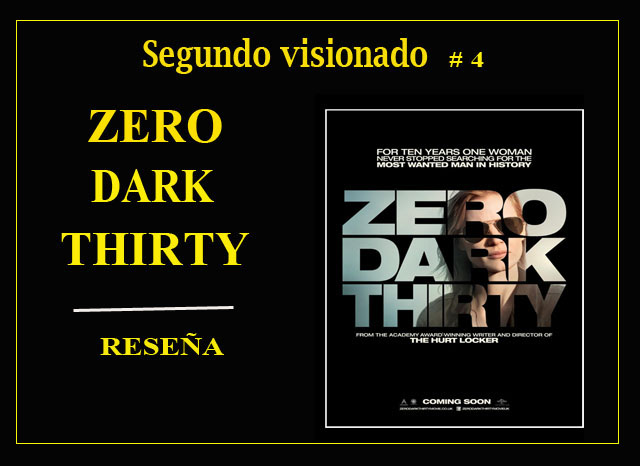
El terrorismo es sin duda uno de los graves problemas de nuestro tiempo, que afecta sobre todo a víctimas inocentes. La intención del terrorismo es crear zozobra y generar un ambiente de incertidumbre donde todos nos sintamos amenazados.
La directora Kathryn Bigelow, primera mujer en ganar un Oscar como directora con la película The Hurt Locker (2009), nos presenta este thriller sobre la larga investigación que logró dar con el paradero de Osama bin Laden, creador de la organización terrorista Al Qaeda.

Maya (Jessica Chastain), es una agente de la CIA proveniente de ese grupo de jóvenes talentosos a los que la Agencia recluta luego de hacerles seguimiento mientras están estudiando. Desde sus inicios en el Organismo de Inteligencia se ha dedicado a investigar todo lo relacionado con Al Qaeda y ha hecho de la búsqueda de Bin Laden su propósito de vida.
Buscando pistas que le ayuden en su afanoso empeño se traslada a Pakistán, a uno de los tantos centros de detención clandestinos que la CIA tenía instalados en todo el mundo durante la administración Bush. Allí conoce al agente Dan (Jason Clarke), un hombre duro que apela a la tortura como método para obtener información.
Dan está convencido que por muy resistentes que sean los prisioneros, “al final todo el mundo se quiebra, es un asunto biológico”. Y en el momento de la llegada de Maya está “trabajando a uno” con el fin de obtener información sobre recientes atentados.
Los primeros contactos de Maya con la tortura en la cárcel de Pakistán la dejan alterada, hasta entonces ella solo había hecho trabajo de oficina, pero entiende que tal como están las cosas lo prioritario es obtener la información necesaria para desarticular las redes terroristas.
Gracias al prisionero de Dan logran una pista importante que la lleva a recorrer diferentes centros de detención en el área del Medio Oriente. Llega un momento en que ella misma utiliza el ahogamiento contra prisioneros como una forma de obtener información. Maya se va endureciendo al sentirse cada vez más frustrada por no obtener resultados favorables a su investigación.
Pasan los años, los atentados terroristas siguen cobrando víctimas en todo el mundo, cambian los directores de la CIA y nada apunta a que se logrará la captura de Osama bin Laden. Osama se ha convertido en un fantasma para los organismos de inteligencia.
Pero Maya no cesa en su empeño. Tal es su entrega que logra el respeto de una buena parte de sus superiores, aunque más de uno considera que su trabajo es solo pérdida de tiempo.
Luego de diez años, un golpe de timón en las investigaciones logrará lo que casi nadie esperaba, dar de baja al que había sido el terrorista más buscado en la historia.
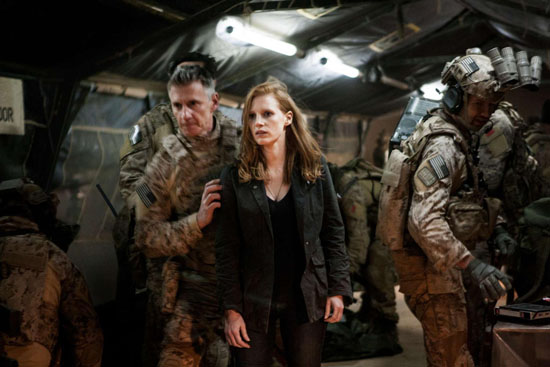

Mientras veía la película pensé que quizá hubiese podido ser menos larga, más de ciento cincuenta minutos para una trama donde no hay grandes conflictos entre personajes y poca acción puede ser excesiva para la mayoría de los espectadores, sin embargo, los ciento treinta y dos millones de dólares recaudados por el film son una muestra de que sí hay público para este tipo de historias.
Son muchos los méritos que tiene la película y que convencieron a los jurados para nominarla entre las mejores del 2012.
Uno, es el excepcional trabajo de cámara. La directora Kathryn Bigelow muestra en este film, tal como lo hizo en The Hurt Locker, su maestría con el uso de la cámara. En apenas cinco o seis segundos de secuencia es capaz de combinar muchos planos, en tomas con ángulos realmente difíciles, a ras del suelo, en posición cenital, con cámara al hombro, sin que resulten discordantes en ningún momento. Esta es una de esas películas que serviría perfectamente para una clase sobre manejo de cámara en el cine.
Otro asunto técnico muy bien trabajado es el uso de la pantalla en negro, apoyada solo con el sonido, para crear atmósferas en el relato. Esto es algo propio del cine, en otras manifestaciones artísticas como la fotografía o la pintura, es muy difícil lograr expresividad solo con el color negro. En cambio la imagen en movimiento más la banda de sonido logra comunicar las más diversas sensaciones.
Una sabia decisión que agradece el espectador es dividir la película en pequeños capítulos, esto facilita llevar la secuencia en una historia tan larga. Cada corte sirve para contar aspectos claves de la investigación, como la aparición de personajes importantes; giros imprevistos, y también para incluir escenas que mantengan el interés en la narración, como son los diferentes atentados terroristas ocurridos en diferentes países.
Me gustó mucho su forma de sugerir la violencia. En otras películas al ocurrir una explosión inmediatamente se echa mano al recurso efectista de mostrar litros y litros de sangre y fragmentos de cuerpo regados por todos lados. La señora Bigelow no necesita nada de eso, para ella es suficiente una columna de humo, el sonido y las luces de las ambulancias, unos cuantos objetos tirados por el suelo, el acompañamiento sonoro, y ya, con eso es suficiente para que el espectador pueda sentir el impacto de un atentado terrorista.

Esta es una de esas películas donde no se hace alarde de un patriotismo desmedido. Si muestra la película el gran nivel que tienen los organismos de inteligencia norteamericanos, pero también muestra sus errores. Además, los estadounidenses no son los únicos que saben de inteligencia, los terroristas también, y mucho. Osama bin Laden, pudo mantenerse oculto tanto tiempo por lo efectivo de su sistema para no dejar pistas que pudieran delatarlo. Claro, siempre habrá la posibilidad de un error y él lo cometió.
Es valiente la Directora en mostrar la presencia de la tortura como una práctica habitual por parte “de los buenos”. Sin embargo, su enfoque es sobrio, solo la muestra unos pocos minutos al inicio de la película, después desaparece del relato. Creo que no toma partido sobre un tema tan difícil, no la condena, no la exalta, deja que el espectador saque sus conclusiones.
La tortura es uno de esos temas que dividen opiniones, sobre todo cuando se siente amenazada la supervivencia, la gente prefiere a veces ver para los lados con tal de que se le garantice seguridad. El problema es que esos procedimientos dan para todo y muchas veces afectan a gente inocente.
De hecho, a nivel de la burocracia ese dilema se plantea en el film, la mayoría de los centros de tortura creados durante los gobiernos de Bush, al calor del atentado del once de septiembre, luego fueron desmantelados en la administración de Barack Obama. Una decisión política, basada en otra forma de entender los derechos humanos, y que fue cuestionada por los directores de los organismos de inteligencia: “si se nos impide tener prisioneros para interrogar, ¿cómo podemos confirmar pistas?” responde un director de la CIA a un operador político cuando le pide pistas sólidas para continuar la averiguación sobre el refugio donde aparentemente se esconde Bin Laden.

La película cuenta con excelentes actuaciones, destaca por mucho Jessica Chastain, Maya, quien fue nominada como mejor actriz para los premios Oscar y que recibió el Globo de Oro por su papel. Uno queda realmente identificado con la voluntad de esta mujer para luchar por lo que cree. Siempre me han parecido admirables esas personas que se entregan con alma y corazón a una idea, y pueden dedicar a ella su vida completa. Maya es una de ellas y Jessica Chastain se encarga de que uno no tenga dudas de eso.
Otra gran actuación es la de Jason Clark, el duro Dan, que acompaña directamente a Maya en la primera parte de la película y luego indirectamente como funcionario burocrático, ya que él mismo se resiente de ese mundo de la tortura y decide irse a un trabajo distinto en las tranquilas oficinas de la CIA en los Estados Unidos.
Otro que siempre destaca es el venezolano Edgar Ramírez, quien funge como compañero y apoyo de Maya en los momentos decisivos para dar con Bin Laden.
Recientemente leí una entrevista a Martin Scorsese, donde él comentaba que la vieja escuela indicaba que cada Director debía escribir su película, esto para que se sintiera su marca de autor. Y establecía una diferencia entre Director y Cineasta. Decía que cualquier Director podía trabajar un guión ajeno, pero solo los Cineastas podían lograr imprimir su marca personal a un guión hecho por otra persona.
La señora Kathryn Bigelow es una gran Cineasta.
Gracias por tu tiempo.
Esta serie lleva el título de segundo visionado porque son películas que vi en algún momento y forman parte de mi videoteca. La película la pueden encontrar en la plataforma Netflix.


Terrorism is undoubtedly one of the serious problems of our time, affecting mainly innocent victims. The intention of terrorism is to create anxiety and generate an atmosphere of uncertainty where everyone feels threatened.
Director Kathryn Bigelow, the first woman to win an Oscar as a director with the film The Hurt Locker (2009), presents this thriller about the long investigation that led to the whereabouts of Osama bin Laden, creator of the terrorist organization Al Qaeda.

Maya (Jessica Chastain), is a CIA agent, from that group of talented young people that the Agency recruits after tracking them while they are studying. Since her early days at the Intelligence Agency, she has dedicated herself to investigating everything related to Al Qaeda and has made the search for Bin Laden her life's purpose.
Looking for clues to help him in his search, he moves to Pakistan, to one of the many clandestine detention centers that the CIA had installed around the world during the Bush administration. There he meets agent Dan (Jason Clarke), a tough man who uses torture as a method of obtaining information.
Dan is convinced that no matter how resilient the prisoners are, "in the end everyone breaks down, it's a biological thing." And at the time of Maya's arrival he is "working one" in order to obtain information about recent attacks.
Maya's first contact with torture in the Pakistani prison leaves her shaken, until then she had only done office work, but she understands that as things stand the priority is to obtain the necessary information to dismantle the terrorist networks.
Thanks to Dan's prisoner, she gets an important clue that leads her to visit different detention centers in the Middle East. At one point, she herself uses waterboarding against prisoners as a way to obtain information. Maya becomes increasingly frustrated at not getting favorable results for her investigation.
Years go by, terrorist attacks continue to claim victims around the world, CIA directors change, and nothing points to the capture of Osama bin Laden. Osama has become a ghost for the intelligence agencies.
But Maya does not cease in her efforts. Such is her dedication that she has the respect of many of her superiors, although more than one considers that her work is just a waste of time.
After ten years, a change of direction in the investigations will achieve what almost no one expected, to bring down the most wanted terrorist in history.


As I watched the film I thought that perhaps it could have been less long, more than 150 minutes for a plot where there are no major conflicts between characters and little action may be excessive for most viewers, however, the one hundred and thirty-two million dollars raised by the film are proof that there is an audience for this type of stories.
The film has many merits that convinced the jurors to nominate it among the best of 2012.
One is the exceptional camera work. Director Kathryn Bigelow shows in this work, as she did in The Hurt Locker, her mastery with the use of the camera. In just five or six seconds of sequence she is able to combine many shots, in shots with really difficult angles, at ground level, in zenithal position, with camera on the shoulder, without being discordant at any time. This is one of those films that would be perfect for a class on camera handling in cinema.
Another very well worked technical issue is the use of the black screen, supported only by sound, to create atmospheres in the story. This is something typical of cinema, in other artistic manifestations such as photography or painting, it is very difficult to achieve expressiveness only with the color black. On the other hand, the moving image plus the soundtrack manages to communicate the most diverse sensations.
A wise decision that the viewer appreciates is to divide the film into small chapters, which makes it easier to carry the sequence in such a long story. Each cut serves to tell key aspects of the investigation, such as the appearance of important characters; unexpected twists and turns, and also to include scenes that maintain interest in the narrative, such as the different terrorist attacks that occurred in different countries.
I really liked his way of suggesting violence. In other films, when an explosion occurs, they immediately resort to the gimmicky resource of showing liters and liters of blood and body fragments scattered all over the place. Ms. Bigelow doesn't need any of that, for her a column of smoke, the sound and lights of ambulances, a few objects thrown on the ground, the sound accompaniment, and that's enough for the viewer to feel the impact of a terrorist attack.

This is one of those films that does not flaunt excessive patriotism. It does show the high level of American intelligence agencies, but it also shows their mistakes. Besides, Americans are not the only ones who know about intelligence, terrorists do too, and very much so. Osama bin Laden was able to stay hidden for so long because of the effectiveness of his system to avoid leaving clues that could give him away. Of course, there will always be the possibility of a mistake and he made it.
The director is brave in showing the presence of torture as a common practice by "the good guys". However, her approach is sober, she only shows it for a few minutes at the beginning of the film, then it disappears from the story. I think it does not take sides on such a difficult issue, it does not condemn it, it does not exalt it, it lets the viewer draw his conclusions.
Torture is one of those issues that divide opinions, especially when survival is threatened, people sometimes prefer to look the other way as long as they are guaranteed safety. The problem is that these procedures can be used for anything and often affect innocent people.
In fact, at the level of the bureaucracy, this dilemma is raised in the film, most of the torture centers created during the Bush administrations, in the heat of the September 11 attack, were later dismantled in the Barack Obama administration. A political decision, based on another way of understanding human rights, and which was questioned by the directors of the intelligence agencies: "if we are prevented from having prisoners to interrogate, how can we confirm leads?" answers a CIA director to a political operator when he asks him for solid clues to continue the inquiry about the refuge where Bin Laden is apparently hiding.

The film features excellent performances, most notably Jessica Chastain, Maya, who was nominated for Best Actress at the Oscars and received the Golden Globe for her role. One really identifies with the will of this woman to fight for what she believes in. I have always admired those people who give their heart and soul to an idea, and can dedicate their entire lives to it. Maya is one of them and Jessica Chastain makes sure one has no doubt about that.
Another great performance is that of Jason Clark, the tough Dan, who directly accompanies Maya in the first part of the film and then indirectly as a bureaucratic official, as he himself resents that world of torture and decides to leave for a different job in the quiet offices of the CIA in the United States.
Another one who always stands out is the Venezuelan Edgar Ramirez, who serves as Maya's partner and support in the decisive moments to find Bin Laden.
I recently read an interview with Martin Scorsese, where he commented that the old school indicated that each director should write his own film, so that his author's mark could be felt. And he established a difference between Director and Filmmaker. He said that any Director could work on someone else's script, but only Filmmakers could manage to stamp their personal mark on a script made by someone else.
Mrs. Kathryn Bigelow is a great Filmmaker.
Thanks for your time.
This series carries the title of second viewing because they are movies that I watched at some point and are part of my video library. The movie can be found on the Netflix platform.
Translated with www.DeepL.com/Translator (free version)

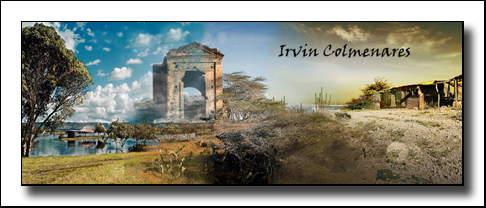




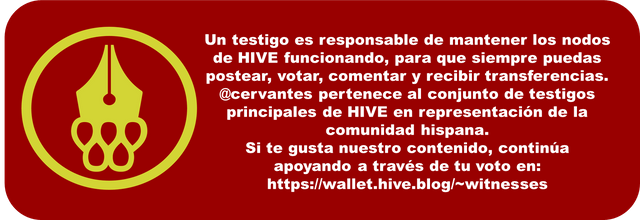
Te invito a apoyar este proyecto como witness y a formar parte de esta gran comunidad uniéndote a su Discord en el siguiente enlace:
Discord de la comunidad Cervantes

You can vote for @ocd-witness, with HiveSigner or on Hive Witnesses.

Otras reseñas de esta serie | Other reviews of this series:


Otras reseñas de esta serie | Other reviews of this series:

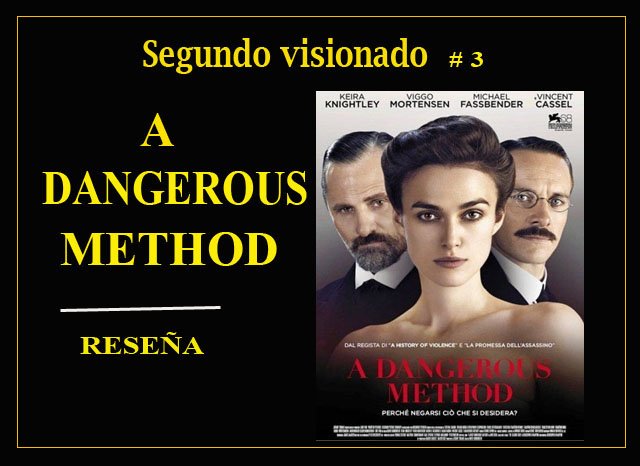
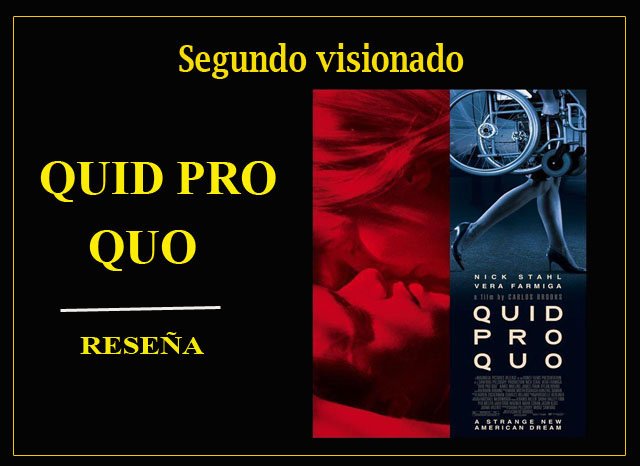

Saludos amigo se ve que es una película interesante que muestra el lado de los organismos de inteligencia de Estados Unidos, y la lucha contra el terrorismo.
Es una buena película, si tienes la oportunidad la encuentras en Netflix, está muy bien trabajo todo el proceso de la investigación para encontrar a Bin Laden. Muchas gracias por la visita y el comentario, estimado amigo @cetb2008. Que estés bien. Bendiciones para la familia.
Me encanto cuando la vi, al igual que el film The Hurt Locker. Kathryn Bigelow es una gran cineasta, con un talento increible para hacernos sentir la tensión en muchas escenas. En su filmografia tiene muy buenas películas, seguramente viste Point Break, esa es un clásico, hicieron un remake hace poco, con Edgar Ramirez, pero fue un fiasco. De ella te puedo recomendar un film del año 89 que me gusto mucho: Días Extraños
Saludos. De Point Break si me acuerdo, era una de las que pasaban en TV. Acabo de ver un trailer de días extraños y la verdad no me resultó conocida, nada extraño porque hay muchas que he visto y al cabo de cinco o diez años se me han olvidado, creo que es eso que llaman el almanaque, jajaja. Pero si es el tipo de películas que me gustan. Muchas gracias por pasar y enriquecer la publicación con tu comentario, estimado @jcrodriguez . Que estés bien. Un fuerte abrazo desde Maracay.
The rewards earned on this comment will go directly to the person sharing the post on Twitter as long as they are registered with @poshtoken. Sign up at https://hiveposh.com.